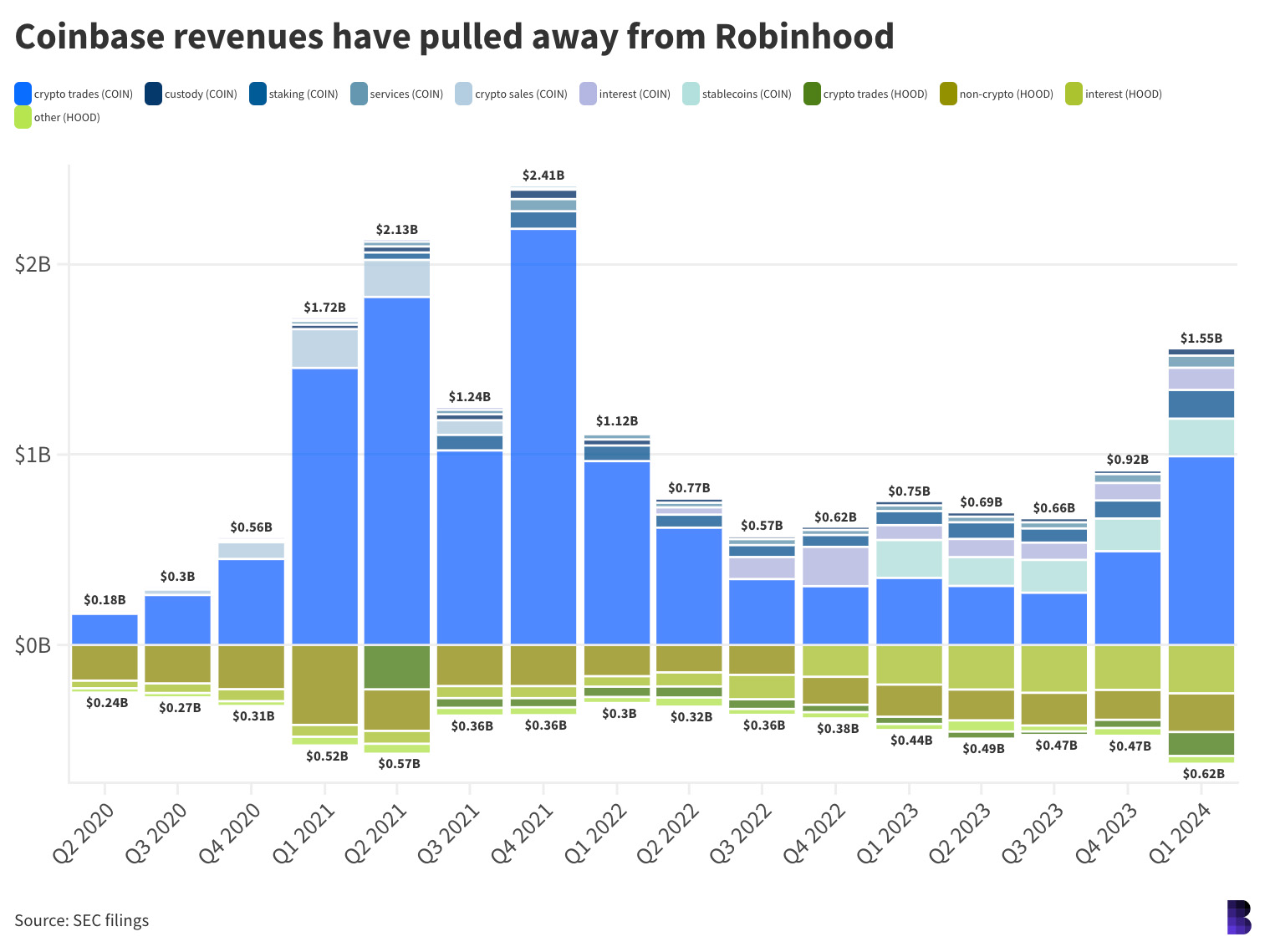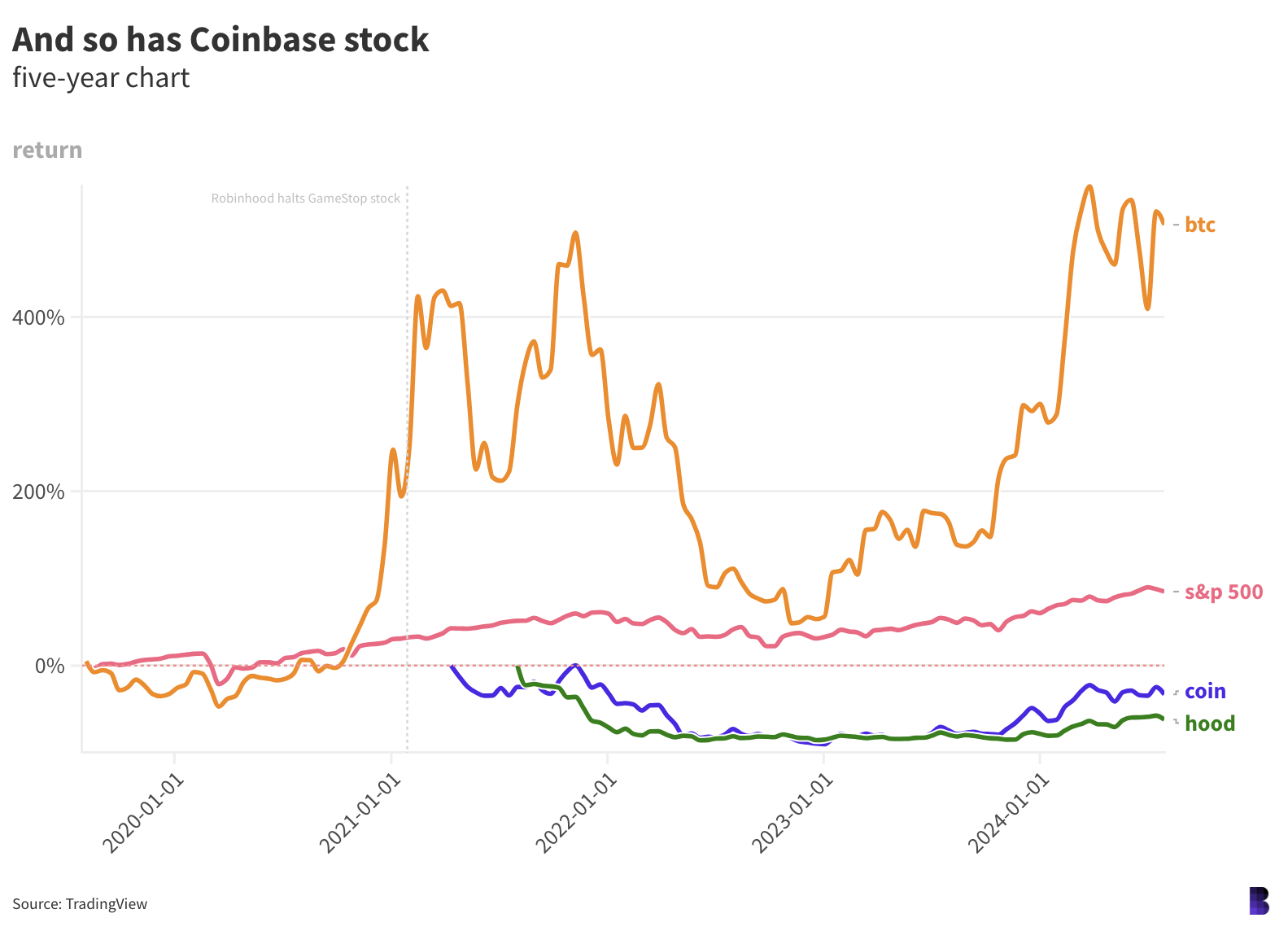Robinhood’s crypto exposure could be its savior — if markets rip
 blockworks.co 31 July 2024 16:37, UTC
blockworks.co 31 July 2024 16:37, UTC We’d all be happy if the bull market kept going. None more so than Robinhood.
Crypto is increasingly important for the stock, which has set its next quarterly earnings release for Aug. 7.
In this year’s first quarter, the Menlo Park firm reported its highest revenues — $618 million, of which crypto contributed 20% — since at least Q2 2020 (before it went public).
The segment was only 9% of Robinhood’s quarterly revenue in Q4 of 2023: $43 million out of $471 million. Had crypto revenues been flat in Q1, Robinhood would’ve posted 13.5% revenue growth instead of 31%.
Read more: Robinhood reports crypto revenue of $43M
Robinhood doesn’t have the widest selection of cryptocurrencies in the US — only 14, and USDC is its sole stablecoin. Most are older cryptocurrencies: bitcoin, ether, bitcoin cash, litecoin, stellar lumens, tezos and ethereum classic. There are two memecoins, dogecoin and shiba inu.
Solana, matic and cardano are noticeably absent — Robinhood got rid of the three after the Securities and Exchange Commission name-dropped them in crypto exchange lawsuits last year.
The SEC has since stopped pursuing securities definitions for that particular trio of cryptocurrencies, and others — at least in the context of its Binance suit.
Read more: Robinhood discloses Wells notice over its crypto business

Over in the EU, Robinhood lists 34 cryptocurrencies — and more memecoins. Specifically, the apex zeitgeist memecoins for this cycle: bonk, pepe and dogwifhat, all of which have seen enormous price rallies over the past year and a half.
Robinhood, unfortunately, doesn’t delineate revenue from crypto trading in the EU and US in its quarterly reports. So, we don’t know how much of its crypto revenue is tied to those memecoins of the moment. Robinhood reported $26.22 billion in customer crypto in Q1, up almost 130% year-on-year amid rising prices.
Still, what’s good for Robinhood’s revenues is good for its stock. But its crypto exposure, as it stands, has only taken the firm so far.
Compare HOOD’s market performance to COIN, a stock that’s all-in on crypto in a way that Robinhood could never be. Coinbase also went public in the very buzzy 2021, less than four months before Robinhood’s initial public offering.
Like Coinbase, which reports earnings on Thursday, Robinhood stock suffered from relatively poor timing in hindsight. Markets were definitely hot in 2021 — that was the mania that brought us Roaring Kitty and Hertz. Attempting to catch lightning in a bottle by going public made some sense.
But when all the craziness subsided, so did the price of bitcoin and other cryptocurrencies, dragging down the price of crypto-exposed stocks like Coinbase, Robinhood and bitcoin miners.
Coinbase briefly saw above zero returns as bitcoin hit its 2021 peak, but as of Tuesday was down 33% over its public trading history. Meanwhile, Robinhood was 62% in the red.
The difference could imply that Coinbase has benefitted from its complete exposure to crypto, not to mention its revenue streams are slightly more diversified, even if entirely within the realm of digital asset infrastructure.

The irony is that the volatility of crypto may be to blame for the situation with share prices, but it could also be their savior — if markets gain significant momentum.
For what it’s worth, data aggregator CoinGecko recently reported that volumes for top 10 CEXs overall were down 12.2% quarter-on-quarter in Q2. If Robinhood saw similar trends, the market response to its upcoming earnings on Aug. 7 could really hurt.
Unless memecoin traders in the European Union were really busy last quarter. Stranger things have happened.




